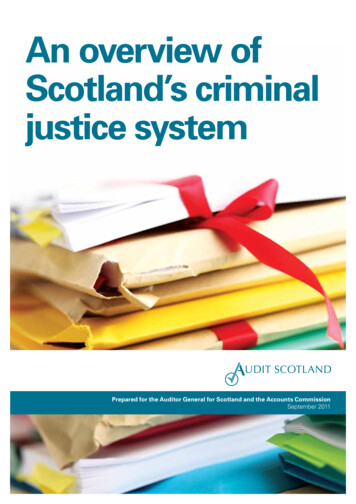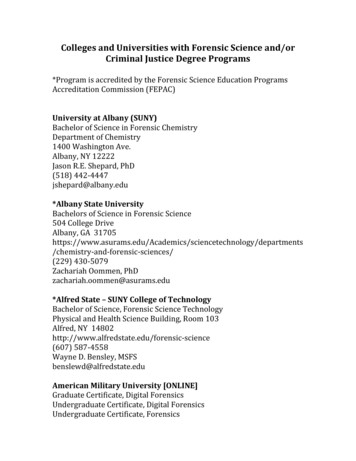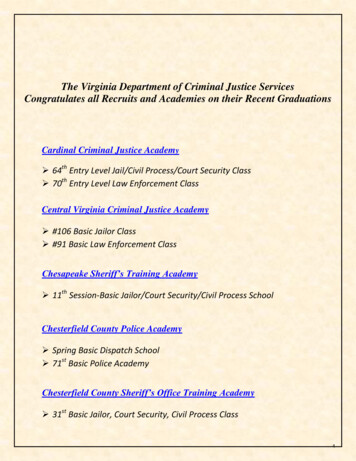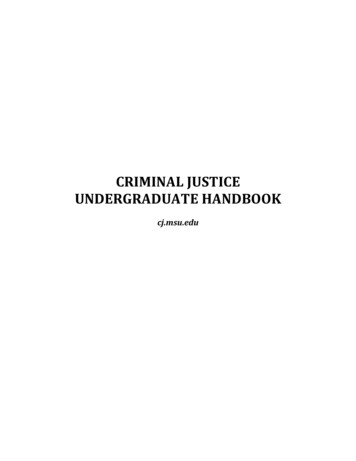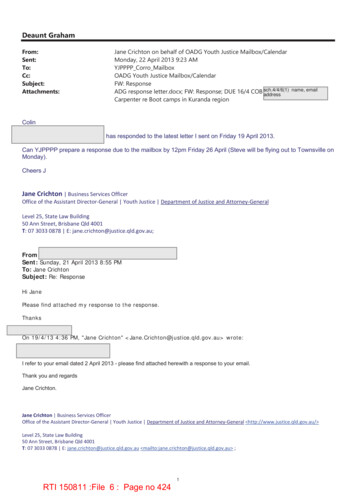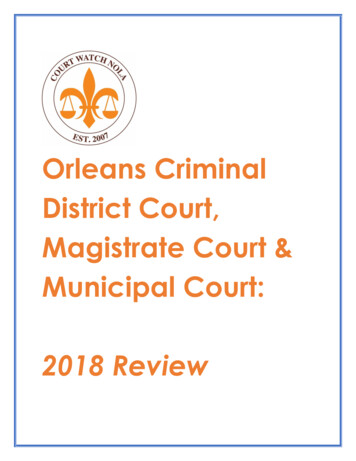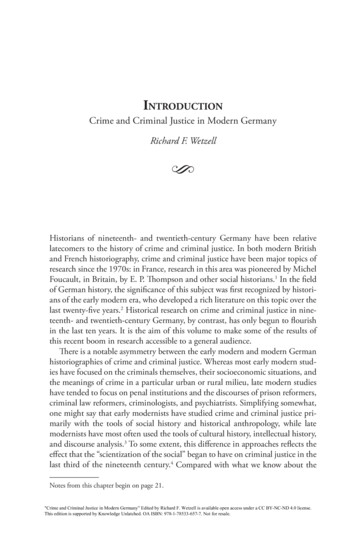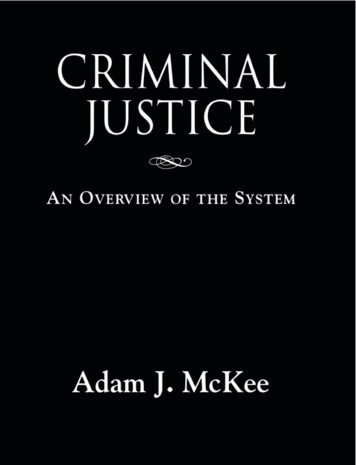
Transcription
This book provides an overview of the criminal justice system of the UnitedStates. It is intended to provide the introductory student a concise yetbalanced introduction to the workings of the legal system as well as policing,courts, corrections, and juvenile justice. Six chapters, each divided into fivesections, provide the reader a consistent, comfortable format as well asproviding the instructor with a consistent framework for ease of instructionaldesign.Criminal Justice:An Overview of the SystemOrder the complete book s/8528.html?s pdfor from your favorite neighborhoodor online bookstore.Enjoy your free excerpt below!
Criminal JusticeAn Overview of the SystemAdam J. McKee
Copyright 2016 Adam J. McKeeISBN: 978-1-63491-263-1All rights reserved. No part of this print publication may be reproduced, stored in a retrieval system, or transmitted inany form or by any means, electronic, mechanical, recording, or otherwise, without the prior written permission ofthe author.Printed on acid-free paper.Booklocker.com, Inc.2016http://www.docmckee.com/OER/
Chapter 1: The Criminal Justice SystemOne of the most important advantages to living in a civil society is the security that it provides. Incontemporary society, the role of ensuring security is relegated to government. That is, citizens have areasonable expectation that society, as a collective, will protect us from rogue members. In giving power togovernment to perform this critical security function, we create the potential for the abuse of that power. Inthe American system of criminal justice, we see two competing and equally important ideas: We demandboth security and freedom from governmental abuse of power. These freedoms are collectively known asindividual rights or civil liberties. These civil rights are woven into the very fabric of our government atboth the state and federal level.In this context, we can view the criminal justice system is a collection of rules and people (usually inthe form of public agencies) working together to protect the public from harm. These elements arecommonly divided into three broad categories: police, courts, and corrections. These three elements havethe same basic function: To respond to crime. A crime is a violation of some criminal law with no legaljustification or excuse. Local, state, and federal governments can make criminal laws. The vast majority ofcriminal laws are a matter of state statutes.Saying that the criminal justice system has the purpose of “responding to crime” results in adramatically oversimplified view of how the system works. Every agency within the criminal justicesystem will agree that it responds to crime, but we find profoundly different mission statements, goals,objectives, and methods among these myriad agencies. A major reason for these differences is that thepublic has several conflicting definitions of the concept of justice.1
Section 1.1: Major Components of the Criminal Justice SystemLearning ObjectivesAfter completing this section, you should be able to:1.1(a)1.1(b)1.1(c)1.1(d)1.1(e)Describe the differences between the individual rights and public order perspective.Describe the need for a system of order maintenance within society and explain the role of lawwithin that system.Explain the structure of the criminal justice system in terms of the three major components usingthe vocabulary of criminal justice.Understand the goals of the criminal justice system.Describe how justice can be defined from various perspectives.IntroductionIn reality, there is no one criminal justice system in the United States. There are many similar systems.Each state has its criminal justice system, and the Federal government has another still. This sectionconsiders how these various systems are composed by looking at the major components common to themall. Traditionally, the criminal justice system can be divided into three major components: Police, Courts,and Corrections.It may seem that there is no real common thread to this system. In the United States, the thing thatbinds all of the components together and regulates them is the rule of law. Philosophically, the rule of lawis the idea that every person is subject to the law, even those that make the law, interpret the law, andenforce the law. The most potent law in the United States is the Constitution of the United States. Thisbody of laws provides all Americans with civil liberties that the government cannot violate. If a state law orfederal law violates any of these protections, then the courts will declare the law void. It is up to theappellate courts, most notably the Supreme Court, to interpret these laws and determine the exact natureand scope of specific civil liberties in the United States. Further, if an agent of the state or federalgovernment violates a person's rights, that person has remedies available. For example, citizens can suegovernment employees that violate their rights under Section 1983 of the United States Code. Animportant remedy in criminal justice is the exclusionary rule. The exclusionary rule was established by theSupreme Court to prevent police misconduct. The rule states that illegally obtained evidence (evidenceobtained in violation of someone's constitutional rights) cannot be admitted as evidence in court.PolicePeople tend to use the word police generically to indicate those individuals with law enforcementresponsibility. The majority of these are municipal police officers, but there are many sheriffs’ deputies aswell as state and federal agents that do not technically fit under the umbrella term “police.” It is importantto realize that enforcing the law is only a small fraction of what the police do every day. They maintainorder and provide many services to the communities they serve. The police also have the responsibility ofinvestigating crimes, collecting evidence, and work with prosecutors to obtain convictions in court.The police are often called the “gatekeepers of the criminal justice system.” This description isaccurate because entry into the system requires formal action on the part of law enforcement. Policeofficers have incredible decision-making authority when dealing with citizens and suspects. An officer canchoose to ignore an offense, issue a verbal warning, issue a written warning, issue a citation, or formally3
Adam J. McKeearrest the person. Of course, the seriousness of the crime plays a major role in how the police exercisediscretion. An officer would not ignore or issue a citation to a person engaged in a serious felony crime.The duties of police officers can be very general in the case of a patrol officer, or they can be veryspecialized, for example, in the case of a homicide detective. The level of specialization depends largely onthe size of the agency where the officer works. Large, urban police departments tend to have moreresources, more officers, and a higher degree of specialization. Despite this fact, the backbone of policing isthe patrol division, and patrol is always a generalist function. The successful patrol officer is a jack-of-alltrades.CourtsWhen law enforcement and prosecutors accuse a person of violating a criminal law, it is up to thecourts to determine if the person did indeed violate the law. If so, it is up to the court prescribe theappropriate punishment (within the scope of the sentencing laws in that court's jurisdiction). Because theAmerican legal system is adversarial in nature, there must always be two teams in any court case. In acriminal matter, a lawyer known as the prosecutor presents the government's case. A major goal of theprosecutor is to see the defendant found guilty of the alleged crime. To use a sports analogy, theprosecutor is the offense. The defense attorney has the job of trying to show that the defendant is notguilty, or at least that defendants should not be accountable for their actions for some legal reason. Tocontinue the sports analogy, the judge serves as a referee, making sure that both sides diligently follow therules of the "game." The jury is tasked with watching the game and deciding (at the end) who the winneris. In the adult criminal justice system, all cases are adversarial in nature. This point will prove to beimportant repeatedly as the workings of the criminal justice system are examined.In a jury trial, the jury serves as the finder of fact. The term finder of fact in this case means that thejury decides whether the defendant is innocent or guilty. In serious cases, the defendant has a right to trialby jury. It is allowable, however, that the defendant consent to a bench trial. A bench trial is a trial wherethe judge takes on the role of the jury as finder of fact.The term courts, used as a general heading, covers a wide array of professionals. It includes defenseattorneys (both public servants and private contractors), prosecuting attorneys, judges, and court staff.CorrectionsCorrections is another umbrella term that is difficult to define because it encompasses so manydiverse criminal justice activities. Corrections can include probation, parole, jail, prison, and myriadcommunity-based sanctions that are becoming more and more popular. Another problem with accuratelydefining corrections is a general disagreement about the philosophy of incarceration. Does society sendpeople to prison as punishment, or for punishment? Do we expect prisons to punish or rehabilitate? Mostpeople can agree on one thing: The public expects correctional institutions to ensure the public safety.A discussion of corrections usually begins with jails. Jails are usually operated at the local level, mostoften under the leadership of a county sheriff. Jails hold several different classifications of prisoners. Jailsare most commonly thought of as holding individuals that have been arrested and are awaiting a firstappearance in court. Legally, these individuals are presumed innocent because they have not been provenguilty. Other jail inmates have been convicted of relatively minor offenses (misdemeanors) and (in moststates) are serving sentences of less than one year. Other prisoners may have been convicted of seriousoffenses, and are housed in the local jail awaiting transfer to a state prison.Persons convicted of serious crimes can be sentenced to a prison term. A prison is generally larger,more secure, and provides more services than a jail. The reason for these extra services is that prisons are4
Criminal Justice: An Overview of the Systemdesigned for long sentences (relative to jail sentences). Prisons are most often run at the state level ofgovernment, but there are also many federal prisons.Defining JusticeOne of the overarching goals that brings the components of the criminal justice system together is thateach is designed (in some way) to promote justice. Everyone has an idea of what justice is, but pinningdown a definition that will be widely agreed upon proves to be a challenge. There are several differentways of looking at the idea. One way to view justice is in terms of equality. In economic language, equalitymeans that everyone gets the same amount, regardless of what they "put in." Another perspective is to viewjustice in terms of equity. When viewed this way, it means that people get what they deserve. In terms ofeconomic reward, those "just deserts" are based on how hard the person works. When it comes to harmsdone to society, many feel that "just deserts" means that criminal punishments should be in proportion tothe harm done. This concept of just deserts in criminal justice has been referred to as retributive justice.The idea of wrongdoers being deserving of repayment in kind is known by the Latin phrase Lex Talionis,or the law of retribution. In its purest form, lex talionis is the Biblical doctrine of "an eye for an eye, a toothfor a tooth." In today's criminal justice system, the idea of retribution takes on the meaning of variablelengths of prison sentences.Both of the above definitions focus on the outcome of an act to determine if it was just. Another way tolook at the idea of justice is to examine the process. In other words, an act is just if it was done using a fairprocess. Justice viewed in terms of fair process is often referred to as procedural justice. This idea leavesroom for debate as to what sort of processes are to be considered fair. Accessibility and predictability arecommon criteria. In the United States, the idea of procedural justice is closely tied to the idea of dueprocess. In a philosophical sense, due process means that agents of the criminal justice system conductcriminal proceedings in a "fundamentally fair" way. In a practical sense, due process means that the statemust respect all legal rights of accused persons. What criminal justice procedures are required under dueprocess is a dynamic body of rules. These rules are most often judicial determinations of what exactly theConstitution means in practice. The idea of due process is represented throughout the Bill of Rights, aswell as being specifically guaranteed by both the Fifth Amendment (applies to the federal government)and the Fourteenth Amendment (applies to state government). Throughout this text, these fundamentalcivil liberties will be discussed in the context of the different elements of the criminal justice system.Police, courts, and corrections must all observe the legal requirements of due process.Amendment VNo person shall be held to answer for a capital, or otherwise infamous crime, unless on apresentment or indictment of a grand jury, except in cases arising in the land or naval forces, orin the militia, when in actual service in time of war or public danger; nor shall any person besubject for the same offense to be twice put in jeopardy of life or limb; nor shall be compelled inany criminal case to be a witness against himself, nor be deprived of life, liberty, or property,without due process of law; nor shall private property be taken for public use, without justcompensation.Note that the Fifth Amendment is constructed in the form of a very, very long sentence. Many differentsubjects are addressed in that sentence. This type of sentence construction is common in the Constitution.When lawyers and legal scholars want to point out a particular phrase within that long sentence, they refer5
Adam J. McKeeto it as a clause. The text specifying that no person shall "be deprived of life, liberty, or property,without due process of law" is known as the due process clause. Some fundamental liberties areexpressed in the constitution in this manner. Other rights, however, are not explicitly stated in theconstitution. The due process clause is of critical importance to civil liberties because it stands in as a proxyfor many other rights. The right to privacy, for example, is never specifically mentioned in the Constitution.Such a right exists, according to the Supreme Court, because it is a necessary element of fundamentalfairness in the criminal justice system.Key TermsAdversarial (legal system), Bench Trial, Bill of Rights, Civil Liberties, Corrections, Courts,Crime, Criminal Justice System, Defendant, Defense Attorney, Discretion, Due Process, Due ProcessClause, Equality (in Justice), Equity (in Justice), Exclusionary Rule, Fifth Amendment, Finder ofFact, Fourteenth Amendment, Incarceration, Individual Rights, Jail, Judge, Jury, Just Deserts,Justice, Lex Talionis, Parole, Police, Prison, Probation, Procedural Justice, Prosecutor, RetributiveJustice, Rule of Law, Sheriff, Sheriff's Deputies, Statute, Trial by Jury, United States Code6
Section 1.2: Roles, Objectives, and Limits in Criminal JusticeLearning ObjectivesAfter Completing this section, you should be able to:1.2(a)1.2(b)1.2(c)1.2(d)1.2(e)Describe the role of each of the three branches of government in shaping the criminal justicesystem.Discuss the critical role of the Constitution of the United States in limiting criminal justice policy.Compare and contrast the common objectives of the criminal justice system.Describe the basic positions of both sides of the "Nonsystem Argument."Explain the importance of rules and discretion in the operation of the criminal justice system.IntroductionBecause the criminal justice system represents a function of the “state,” each of the Three Branchesof Government has a role to play. Each branch has different responsibilities; thus, each branch depends onthe other to function properly. Keep in mind that each of these three branches of government exists on thefederal, state, and local level. Each of these levels of government dominates some aspect of the criminaljustice system. Law enforcement is primary a local government function, as are jail operations. Makingcriminal laws and operating corrections agencies is primarily a state function. The federal governmentduplicates all criminal justice functions on a national scale. Ultimately, prisons, jails, and correctionsprograms can be operated at all levels of government. In practice, one level of government tends todominate each particular function within the criminal justice system.The Role of the LegislatureThe term legislature refers to lawmaking assemblies such as the Congress of the United States or thelaw making bodies of all the states. Legislatures have many important functions in the criminal justicesystem. Perhaps the most direct function is that the legislature determines what acts are crimes and what thepunishment is for particular crimes. They do this by enacting statutes. Official versions of the law that areorganized by subject are called codes. Thus, when we refer to the criminal code (also called the penalcode) we are referring to a collection of statutes that define crimes. In the dual federalist criminal justicesystem of the United States, state legislatures are the source of the bulk of criminal laws. Another crucialrole of the legislature is to provide funding for criminal justice agencies and programs. Without funding,criminal justice activities would halt.The Role of the JudiciaryThe role of the judiciary in criminal justice is complicated by the hierarchical nature of the courtsystems. This hierarchy can be simplified by dividing courts into two major categories: trial courts andappellate courts. Trial courts adjudicate the guilt of people charged with crimes and impose sentence onthose determined to be guilty. Hollywood leads to the conclusion that most criminal cases result in a trialby jury. This is substantially incorrect. The fact is that most criminal defendants who do not have theircharges dropped prior to being formally charged will plead guilty. Most of those guilty pleas are a result ofplea bargaining, an unglamorous but necessary process that takes place largely out of the public view.7
Adam J. McKeeAppellate courts are different in that they do not conduct criminal trials. Rather, they hear complaintsraised by people who were not satisfied with their treatment by the trial court or some other aspect of thecriminal justice system. The appellate courts can hear these complaints because they have the power ofjudicial review. Judicial review means that the appellate courts can review a law made by the legislatureand determine if it meets constitutional standards. At the federal level, this means the standards set forth inthe Constitution of the United States. At the state level, state appellate courts can determine if statelegislatures have acted within the limits of that state’s particular constitution. If the high court determinesthat a law is unconstitutional, then the law becomes void.Appeals courts also have the power to review the actions of government employees, such as lawenforcement officers and correctional officers. The most important appellate court in the United States isthe United States Supreme Court. The day-to-day activities of police officers, for example, are heavilyinfluenced by Supreme Court decisions dictating how the police must treat suspects and evidence. Keep inmind that the United States has dual court systems due to the structure of the American government. In alater section, the differences between the state and federal court system will be examined.The Role of the ExecutiveThe executive branch of government includes the offices of the president of the United States,governors of the fifty states, and the mayors of America’s many towns and cities. Often these individualsare directly responsible for many appointments within the criminal justice system. Mayors appoint chiefs ofpolice in many towns and cities. Governors appoint law enforcement heads as well as correctionalleadership. The president appoints federal judges, including those who sit on the Supreme Court.The executive has a key role to play in setting criminal justice agendas and galvanizing public opinion.A theme that permeates any discussion of the criminal justice system is the use and misuse of discretion.The term discretion is used to indicate the power that agents of the criminal justice system have to makedecisions based on personal judgments. At this point in the text, the discussion centers on discretion at thehighest levels of government, and how that discretion influences the criminal justice system. In latersections, the discussion will turn to how the use of discretion by officers in the field influence the operationof the system and impact the lives of citizens.Common ObjectivesThe Bureau of Justice Statistics (1993) has identified three common goals of every element of thecriminal justice system. These are efficiency, effectiveness, and fairness. Efficiency means economicallyapplying available resources to accomplish statutory goals as well as to improve public safety.Effectiveness refers to carrying out justice system activities with proper regard for equity, proportionality,constitutional protections afforded defendants and convicted offenders, and public safety. Fairness refersto justice issues such as assuring equal treatment and handling of like offenders and giving equal weight tolegally relevant factors in sentencing. Fairness is of such great importance because it is enshrined in theConstitution of the United States under the catchall phrase due process. Note that the Supreme Court hasfocused on procedural due process as the ultimate measure of justice in the United States. That is, thesystem of concerned with everyone being treated the same as they are processed through the system. Moreoften than not, the fairness of individual outcomes is of little concern.8
Criminal Justice: An Overview of the SystemThe Constitutional FrameworkNo matter where you live in the United States, you are protected by two independent criminal justicesystems. There is always the federal system as well as the system of the state. This means that at both thestate and federal level we find those who enforce the law, those who adjudicate the law, and those whopunish and rehabilitate offenders. While these broad goals are the same, the particulars are quite different.The system is further complicated by the fact that most law enforcement in the United States is doneon a local level. Thus, local officers are enforcing state laws. Offenders sentenced to a period ofincarceration can serve their time in local jails or state run penitentiaries. The federal system is lessconvoluted in that federal agents investigate federal crimes, and federal prosecutors take those cases tofederal courts.By far, state and local government takes on the largest share of the criminal justice burden. As citizens,the local police departments and sheriff’s departments that serve us are whom we depend on to protect usfrom criminal harms.The Nonsystem ArgumentOne of the most enduring debates about the criminal justice system of the United States is whether it isa system at all. The term system suggests components that work together to achieve some overarching goal.Critics argue that no such thing happens in American criminal justice. They argue that the police, courts,and corrections agencies act independently of each other with different financial resources and differentgoals and objectives. Many critics see a failure to organize around a central purpose, and thus we find thatthe criminal justice system is no system at all. This position is known as the Nonsystem Argument.RulesOne common aspect of all criminal justice systems within the United States is the abundance of rulesthat govern criminal justice activities. These rules are hierarchical. The most important and enduring rulesthat must be followed by agents of the criminal justice system are those enshrined in the Constitution of theUnited States. Most of the safeguards of American civil liberties against intrusion by the government arecontained in the Bill of Rights. The Bill of Rights is the first ten Amendments to the Constitution.After the federal constitution and the constitution of the states comes federal and state statutes. Thecollection of federal statutes organized by topic is called the United States Code. States have a criminalcodes as well. There are also court rules established by the high courts that bind the lower courts as well asagents of the criminal justice system. At the federal level, these are known as the Federal Rules ofCriminal Procedure. In addition to these various laws, there are agency rules and regulations that agents ofthe criminal justice system must follow.DiscretionDiscretion refers to the authority the public gives agents of the criminal justice system to makedecisions based on their own professional judgment. Discretion is necessary because formal rules cannottake into account every contingency criminal justice professionals encounter in practice. To functioneffectively, criminal justice professionals must make judgment calls. Discretion is called for when a policeofficer makes a decision as to whether to stop a motorist, question a suspicious person, issue a citation,make an arrest, or use deadly force. Prosecutors use discretionary powers daily in their work. Decisions9
Adam J. McKeemust be made as to what to charge a person with, whether or not to offer a plea bargain agreement, and soforth.Juvenile JusticeFor much of history in the United States, children were treated the same as adult criminals. Accordingto common law, the defense of infancy was available to children below the age of seven. The idea was thatvery young children were not culpable because they lacked the capacity to understand the wrongfulness oftheir actions. After age seven, the infancy defense disappeared, and children could face prison and evendeath. During the 19th century, society’s view of children began to change. People began to realize thatchildren were not merely miniature adults. They were still developing cognitively and morally. This newview of adolescence spawned a revolution in juvenile justice and led to a completely separate way ofdealing with youths that committed crimes. The Juvenile Court movement began in the United States atthe end of the Nineteenth Century. From the juvenile court statute adopted in Illinois in 1899, the systemhas spread to every State in the Union, the District of Columbia, and Puerto Rico.Early reformers found the prospect of children receiving long prison sentences and sharing prisonspace with adult criminals appalling. There was also a conviction that the duty to children went beyondmere justice. The reformers believed that it was the duty of the state to step into the role of the parent whenthe parents either would not or could not correct the wayward child. Unlike adults, children wereconsidered fundamentally good. The rigid and cold adult system was not appropriate for children; both thesubstantive and the procedural criminal law had to be discarded in favor of a system that fostered the bestinterest of the child. Thus, from inception the focus of the juvenile system was "treatment" or"rehabilitation."Key TermsAppellate Court, Bureau of Justice Statistics, Code, Common Law, Congress of the United States,Constitution, Criminal Code, Decisions (courts), Dual Court System, Dual Federalism, Effectiveness,Efficiency, Executive Branch, Fairness, Federal Rules of Criminal Procedure, Hierarchical, InfancyDefense, Judicial Review, Judiciary, Juvenile Court Movement, Juvenile Justice, Legislature,Nonsystem Argument, Penal Code, Plea Bargain, Procedural Due Process, System, Three Branchesof Government, Trial Court, Unconstitutional, United States Supreme Court10
Section 1.3: Defining and Measuring CrimeLearning ObjectivesAfter completing this section, you should be able )1.3(i)1.3(j)Name and describe the three major national crime data-gathering programs in the United Statestoday.Discuss what crime statistics tell us about crime in the United States.Describe the limitations of the three major national crime data-gathering programs in the UnitedStates today.Describe the FBI’s Crime Index, and list the Index Crimes.Define crime rate and explain why crime statistics are generally expressed as rates rather thancounts or percentagesDefine the hierarchy rule and explain how it impacts crime reporting.Discuss the meaning of the term clearance rate and describe how it is different than the crime rate.Describe the development of the NIBRS, and identify why it is superior to the UCR.Compare and contrast the purpose and data collection methods of the NIBRS with the NCVS.List and define each of the Part I offenses as used in the UCR.IntroductionA crime is an act or omission that is prohibited by law. For a law to be valid, a particular punishmentor range of punishments must be specified. In the United States, the most common punishments are finesand imprisonment. As a matter of legal theory, a crime is a failed duty to the community for which thecommunity will exact some punishment. This is the reason that prosecu
3 Section 1.1: Major Components of the Criminal Justice System Learning Objectives After completing this section, you should be able to: 1.1(a) Describe the differences be
